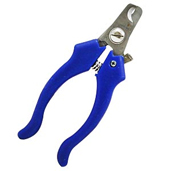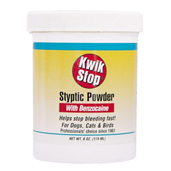Regular grooming is a part of responsible
dog ownership, and this includes taking care of your pet's nails.
Toenails that are allowed to grow too long can puncture a dog's foot
or get snagged and be pulled off. Both conditions are very painful.
Long toenails also increase the risk that a dog will scratch a person
or damage floors or other parts of the house.
How to Trim Your Dog's Nails

Many owners are intimidated by the
thought of trimming their dog's toenails, but it's not very
difficult. First, get yourself a good tool. A sharp, new nail trimmer is much easier to use and puts less pressure
on the sensitive parts of a dog's nail. Many different types
of nail clippers are available. Pick one that fits the size of
your dog. Nail
scissors are best reserved
for small breeds.
Next, get your dog used to having his
feet handled. Some dogs seem to be very sensitive in this area,
so start by making it a pleasant experience for everyone. Sit
with your dog, pet him, and gradually move down his leg to his feet.
Praise him or even give him a treat when he lets you play with his paws and wiggle
his nails without pulling away. If after multiple attempts this
type of training does not work, you might need to consider giving your
dog something to help with anxiety.
Know the anatomy of a canine toenail.
The part farthest from the foot does not have any blood vessels or nerves
and so clipping in this area is not painful. But, if you move
far enough back on the nail, you will hit the quick. This does
hurt and can bleed, very much like pulling or breaking your fingernail
back too far, but it is not the end of the world. Have some Kwik-Stop Styptic Powder or a styptic
pencil on hand to stop
the bleeding just in case.

If your dog has white nails, you should
be able to see the triangular, pink quick inside. Clip the nail
a few millimeters away from there.
Trimming black nails is a little
more challenging. The first few times, start by just removing
a few millimeters from the end of the nail at a time. As you get
close to the quick, you will start to see a black area of tissue surrounded
by a lighter circle at the cut end of the nail. This is a good
place to stop. As you get to know your dog's nails, you will
become more comfortable with taking larger pieces off at one time.
If you just can't bring yourself
to use a clipper, you can use a pet nail file or grinder. You still need to be careful
to avoid the quick, but because these tools remove the nail more gradually,
they can be less intimidating. Files are also good to smooth out the edges of a
nail cut with trimmers.
If all else fails, make an appointment
with a groomer or veterinarian to get your dog's nails trimmed.
There is nothing wrong with letting someone else be the "bad guy"
if home nail care is just too traumatic for you and your dog.
The above is provided for information purposes only and should not be used for the diagnosis or treatment of any condition.
This information does not cover all possible variables, conditions, reactions, or risks relating to any topic, medication, or product and should not
be considered complete. Certain products or medications may have risks and you should always consult your local veterinarian concerning the treatment of
your pet. Any trademarks are the property of their respective owners.